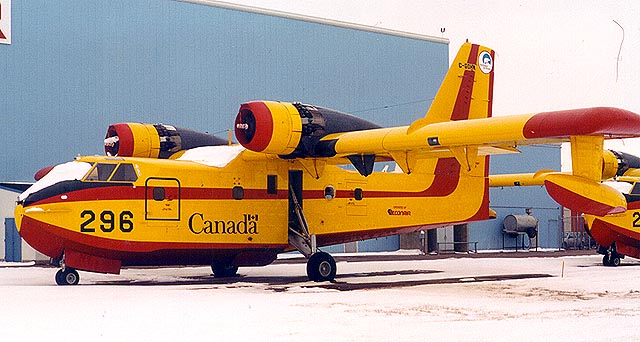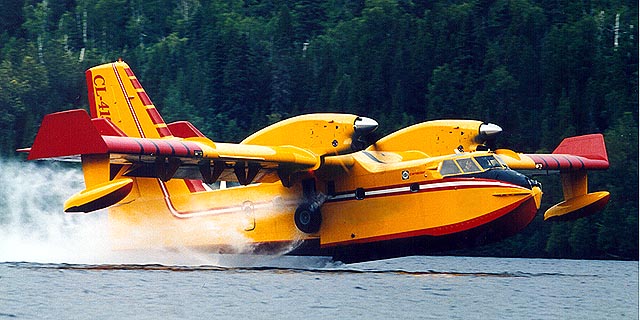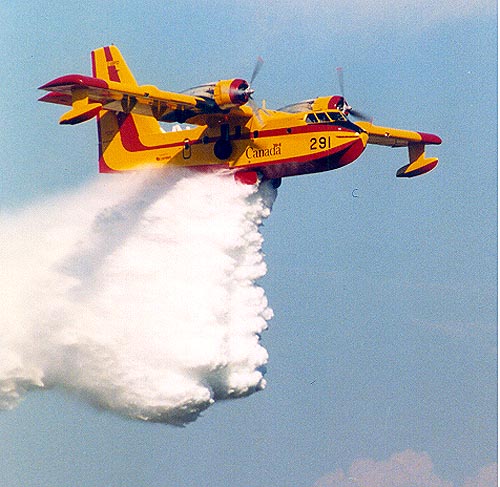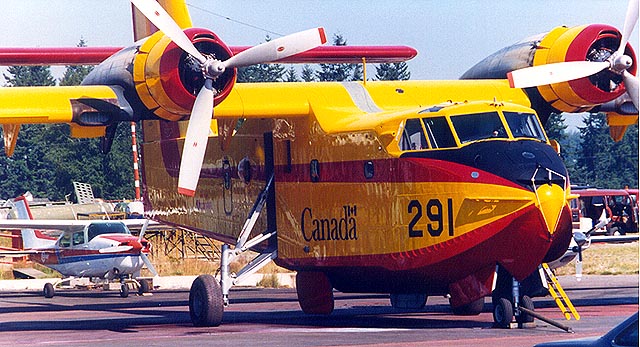Readers wishing to learn more about firefighting air tankers may wish to go to
Global Emergency ResponseThere's a wealth of information there about the U.S. Forest Service's continued lack of interest in aggressively addressing the wildland fire situation in the USA. The Russian government has for years had a standing offer of the use of the massive Ilyushin aircraft for testing and use in the US, free of charge, with the only request being fuel for the aircraft and temporary housing for it's crews...and the U.S. Forest Service has always declined. These mammoth jet air tanker s dwarf even the largest firefighting air tankers in the U.S. arsenal, and have been proven effective in huge wildfires in Russia, Greece, Australia and elsewhere.
Rep Dana Rohrabacher R-CA and Curt Weldon, R-Pa have worked hard in past times to help in these matters, as discussed here: "Could Russian Waterbomber Save California?"
but apparently it's all fallen apart at this point. If your home burns this year as a result of a wildfire, be sure to send a nice thank-you to the U.S. Forest service, who have done everything they can to block measures to pursue truly effective wildland firefighting methods.
1 posted on
05/10/2004 11:14:43 PM PDT by
Stoat
To: farmfriend
Ping
2 posted on
05/10/2004 11:21:12 PM PDT by
tertiary01
(DEMS- the other surrender monkeys.)
To: Stoat
4 posted on
05/10/2004 11:28:07 PM PDT by
Carry_Okie
(There are people in power who are truly stupid.)
To: Stoat
``It was apparent that no effective mechanism currently exists to ensure the continuing airworthinesss of these firefighting aircraft,'' the report said. That being the case they have decided wisely.
Contiued airworthiness MUST be maintained, lest the aircraft be patched together with auto parts and radio shack components and crews would be flying on more "prayer" than "wing".
7 posted on
05/10/2004 11:45:46 PM PDT by
EGPWS
To: Stoat
I look out my office window everyday at a mountain range here in SoCal with square miles of dead fir trees. Enviroweenies wouldn't let the diseased trees be cut down. Now we have another fire season, another year of drought and I pray to God we don't have the another horror like last year.
Red
To: Stoat
The
Martin Mars was retired a couple of years ago in Canada.
Firefighting certainly wasn't what Glenn L. Martin had in mind for the design of the Martin Mars. Originally conceived as a bomber for long range missions and patrols, the production aircraft were redesigned and classified for long-range general transport because of the demonstrated heavy-lift capability of the prototype. The "Big Four", as they were affectionately known, established airlift and endurance records which remain valid today and they logged some 87,000 accident-free hours before being retired by the USN and sold to Flying Tankers. Mr. Martin would be very pleased to know his original intention of the Mars in a bomber role came to pass in their second career as waterbombers.

Philippine Mars
White Tail - side drop system
Canadian Registration C-FLYK
S/N 76820

Red Tail - bottom drop system
Canadian Registration C-FLYL
S/N 76823
During the fire season, the aircraft are kept in a state of readiness to meet the existing fire hazard conditions. They can be in the air in ten minutes and, based on historical data, each can make a drop every fifteen minutes. Working in tandem, this equates to 7,200 US gallons (27,276 litres) every seven minutes and each drop can cover an area of up to 4 acres (1.6 hectares). It has often been said that the Mars, with a 60,000 pound (27,216 kilogram) payload of foam, is like "hand-grenades or horseshoes - close is good enough" but such is not the case. The highly experienced Mars pilots, working closely with the fire boss, deliver the water or foam right where it is needed.
Each Mars carries 600 US gallons (2,270 litres) of foam concentrate - enough for 21 drops of a 0.4% solution which is the standard used although it may be decided to use more or less foam as dictated by the Fire Boss.
23 posted on
05/11/2004 5:02:26 AM PDT by
OrioleFan
(Republicans believe every day is July 4th, DemocRATs believe every day is April 15th. - Reagan)
To: Stoat
I think we need a huge fleet of these:
(Ignore the fact that they're 'canadian')
|
Air Power
Canadair CL-215/415 "Super Scooper"
 |
The Canadair CL-215 was the first aircraft ever designed specifically for Water Bombing. While the PBY Canso was modified from it’s role as a military submarine patrol aircraft, the CL-215 was created as an actual Water Bomber.
After departing the airport, the CL-215 crew of two heads directly for a suitable ‘scooping’ lake as close to the forest fire as possible. An inspection run is made on the lake to insure that it is of suitable length and has no obstructions which could hamper the safety of the aircraft and flight crew. The aircraft then touches down on the lake and ‘scoops’ 12000 lbs of water into the internal tanks within ten seconds. At this point the water pickup probes are retracted and the aircraft leaps into the air, heading towards the fire. The Air Attack Officer on board the birddog aircraft instructs the water bomber flight crew where and how to drop the load. He may ask that the crew inject a harmless soap-like solution into the water tanks through an onboard computer. This will give the water a foam-like consistency to help increase it’s holding time at the fire. As there are two water tanks onboard the aircraft, both loads of water may either be dropped together or separately as the fire conditions dictate.
With the ability to scoop in close proximity to the fire, the CL-215 is able to deliver an enormous amount of water within a very short time. This provides excellent Initial Attack and Sustained Action support for ground crews on the fire line.
|
Specifications
Primary Function: water bomber
Length: 65'
Wingspan 93' 11"
Speed: 236 mph
Ceiling: 20,000 feet
Range: 1,513 miles
Year Deployed: 1994
|




All photos Copyright of their respective websites
27 posted on
05/11/2004 6:07:03 AM PDT by
Johnny Gage
(God Bless our Firefighters, our Police, our EMS responders, and our Veterans)
To: Stoat
I took a summer position with the USFS in MT to fight fires. It was the best experience to date. Dozers and weather were the only real defense to a raging fire. We just tried to contain the fires until we got a thunderstorm or we waited for autumn. Small fires we could control and put out using hand tools and water if it was close enough to a supply.
BTW, has anybody read about how terrorists have planned to use forest fire in populated areas as a weapon? With all of the recent fires and fires of last year and the year before, can there be a connection?
To: Stoat
The government also can activate eight military C130s equipped to carry water, he said. Better check with DOD first. These 8 military C-130's are Air National Guard. Operations Enduring Freedom and Iraqi Freedom are higher priority than western forest fires -- unless they just activate us all for both.
39 posted on
05/11/2004 10:43:34 AM PDT by
gcraig
To: Stoat
I was just about to make the point about the Russian aircraft offer. I can only surmise from the governments actions that they're not really serious about containing wildfires. Our government doesn't seem to much use for anything but collecting taxes.
44 posted on
05/11/2004 11:53:26 AM PDT by
dljordan
To: Stoat
An air tanker sounds like a good use of UAV technology....
To: Stoat
There's actually a few things we can do to fight wildfires:
1. Make a huge buy of Canadair CL-415 water bombers for the US Forest Service, maybe as many as 100-125 planes. The CL-415 is probably one of the best of its kind, designed specifically for the rigors of low-level flying needed for water bombing.
2. Modify a number of rebuilt C-130E/H Hercules planes to drop containers loaded with water that looks like a dodecahedron. Popular Mechanics mentioned idea this late in 2003 and they said this allows for more wider area coverage of flame-retarding water and also allow the drop plane to fly higher, too.
3. Fill artillery shells and/or short-range bombardment rockets with liquid nitrogen and fire them directly into the fire. When the shell or rocket filled with liquid nitrogen explodes in the fire, the combination of sudden extreme cold and the quick removal of oxygen to feed the flame at the impact point will quickly put out the fire. And unlike conventional fire retardants, liquid nitrogen will quickly evaporate away and not become an environmental hazard. I remember at the end of Operation Desert Storm they actually tried it out and it did work to put out the oil well fires.
To: snopercod; joanie-f
"The planes were reactivated after a new inspection program was developed at the Energy Department's Sandia National Laboratory in Albuquerque, N.M., but the NTSB said in its report last month that maintenance and inspection programs were still inadequate."
Well, you might conclude, that, when your muffler falls off the car, and you go to the telephone company to fix it, that "maintenance and inspection programs were still inadequate."
You see how easy it is, at times, to spot the "39%" in the Bush [still running 39% of the Clinton] Administration?
It is on this note, that I take my leave.
See you in a couple months.
47 posted on
05/11/2004 2:39:17 PM PDT by
First_Salute
(May God save our democratic-republican government, from a government by judiciary.)
To: Stoat
Those c-130's were never designed to air-drop loads like that in wildfire updrafts. In the late 60's many of those planes had special splices installed over the wing strut connections over the fuselage, exactly where it broke off of the tanker. Vietnam had short airstrips and they were rough. The C-130's occaisionally pulled 9-10 G's on landing and their wings flopped liked goony birds. You could see what was going on. When they x-rayed them in Japan they found 1/4-1/2 inch breaks in the Main wing spars. We had one plane per month go to Japan for the "Special fix". Anyone with a brain knew what was happening. None of those poor souls contracting with those old planes knew about the reports. They probably weren't told about them when they bought the planes. I wonder haw many of them had the "Special Fix" done to them?
To: All
Thank you all so very much for your great posts! I've read them all and really appreciate the thought and oftentimes the tremendous expertise that is evident in the posts. I found a related article today that readers on this thread might enjoy, so I'll just post it here rather than start a new thread with it. If anyone thinks that it's REALLY newsworthy you're welcome to post it as a new thread yourself if you like. If you do, you might want to provide a link over to this thread so that new readers can see the great links, photos and posts that everyone here has contributed. Here's the article:
Loss of air tankers may affect wildfires - Experts applaud putting safety first Loss of air tankers may affect wildfires - Experts applaud puttingsafety first Copyright 2004 The Post Register Idaho Falls Post Register (Idaho Falls, Idaho) May 12, 2004 Wednesday Idaho fire experts believe the decision to terminate contracts for 33 large air tankers will have a definite impact on national fire operations, but most applaud the federal agencies' decision to put safety first. The decision announced Monday is in response to a National Traffic Safety Board report on three air tanker accidents that occurred between 1994 and 2002. The report determined the federal government's maintenance and inspection procedures for firefighting air tankers were inadequate. The loss of large air tanker support could result in more wildfires escaping initial attack and becoming "large, problem fires," former Bureau of Land Manager aviation manager Hugh Carson said. "Air tankers are a very important tool in the tool box. It's not just another tool we can easily do without," he said. "No amount of single engine air tankers or helicopters can replace the key role that air tankers play." The National Interagency Fire Center in Boise will still be able to call on eight military C-130 tankers that have been modified to provide fire support. Two of the firefighting C-130s are available at bases in North Carolina, California, Wyoming and Colorado, Lt. Col. Ellen Krenke of the National Guard Bureau said. The eight aircraft are not dedicated exclusively to fires, and because of the massive deployments to Iraq the military has had to prioritize aircraft use. But, the aircraft should be able to respond when requested, Krenke said. In the past, military aircraft have only been requested when the center is at its highest level of fire danger. Carson said it will be tough to face an extreme fire year without tanker support but that the Forest Service did the right thing. Forest Service and Department of Interior officials say they are trying to develop a strategy to purchase newer aircraft, something Carson said is long overdue. "Clearly the days of operating older aircraft of unknown airworthiness for firefighting operations are over," Forest Service Chief Dale Bosworth said in a statement. Gina Knudson, who covers Lemhi and Custer counties for the Post Register, can be reached through Assistant Managing Editor Margaret Wimborne at 542-6757.
60 posted on
05/12/2004 11:30:28 PM PDT by
Stoat
FreeRepublic.com is powered by software copyright 2000-2008 John Robinson






